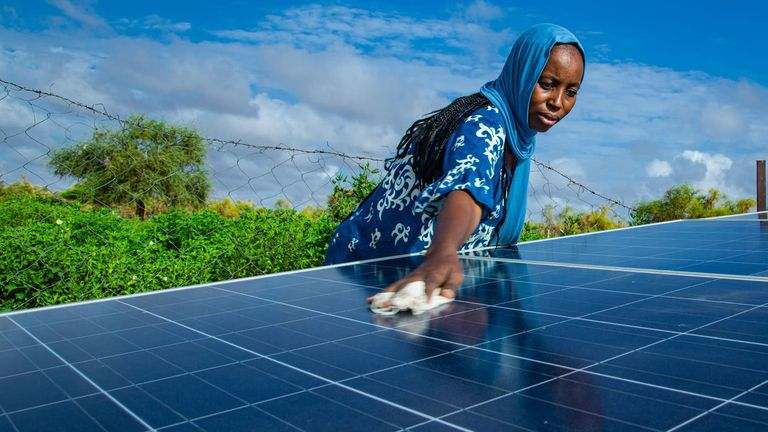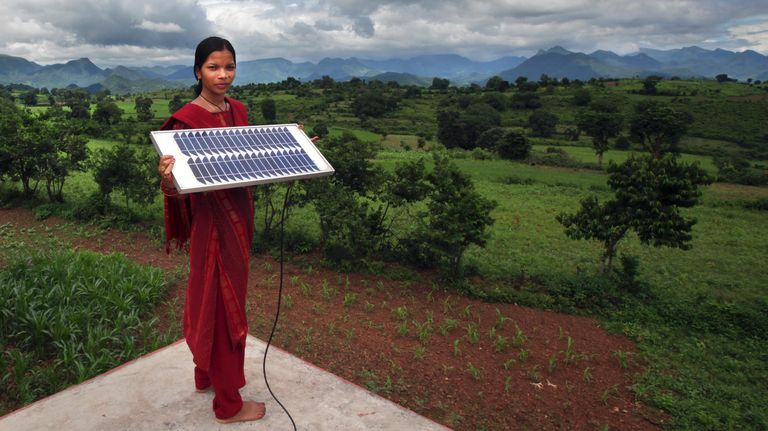Green Trend Globally There Has Never Been So Much Electricity From Wind And Sun

A woman cleans the solar panels in her neighborhood in Mauritania: small systems contribute to the global green electricity record
just as much as huge wind and solar parks. (Source: Raphael Pouget / Climate Visuals Countdown)
A tenth of the world’s electricity now comes from wind and solar energy. Germany is way ahead internationally – and still has to stretch itself.
The number seems relatively small, but it is an important milestone. Wind power and solar energy covered 10% of global electricity consumption for the first time last year, according to the latest analysis by the British Energy Institute Ember. At no other time has the earth’s power supply been so green.
A total of 50 countries now manage to generate at least a tenth of their electricity from wind and sun. In 2021 only, energy generation using wind power increased by 14%, and PV by as much as 23%.
Combining wind power and solar power, the two now make up the world’s fourth-largest source of electricity. On average, they cover 10.3 % of the earth’s total electricity consumption, the highest level ever.
Great progress in poorer and fossil-heavy countries
While Germany, the USA and Great Britain had already broken the 10% mark, the large economies of Japan and China also reached this level last year.Likewise, Mongolia, El Salvador, Argentina, Hungary and Vietnam are now generating at least a tenth of their electricity from wind and sun – with Vietnam switching to green sources particularly rapidly.
Within just two years, it was possible to increase the share of wind and solar energy in the electricity mix from less than 1% to almost 7%. The growth in this area was just as fast in Australia, which is otherwise better known for its heavy dependence on coal energy.

Meenakshi Dewan is a Photovoltaic Engineer based in the eastern Indian state of Orissa. India still only generates around 8% of its electricity from sun and wind. However, some villages already obtain their electricity exclusively from solar cells. (Credit: Abbie Trayler-Smith / Panos Pictures / Department for International Development)
Meanwhile, a Scandinavian country is leading by example. The world’s highest proportion of green electricity from wind and sun was achieved in Denmark last year: Germany’s northern neighbor covered 52% of its total electricity requirements with the help of photovoltaic and wind power plants alone.
And it has shown that such renewable energies can also be fed into the power grid on a large scale, which are rather variable due to changing sunshine duration and wind strength. After Denmark, Uruguay and Spain, Germany ranks fourth internationally with its share of solar and wind power.
Despite the success: there is still a long way to go
Overall, the share of wind and solar power in the global electricity mix has doubled since the Paris Climate Agreement was agreed in 2015. That is a small glimmer of hope in terms of the energy transition.
“Celebrating success is always good and motivates us to continue,” says Volker Quaschning, Professor of Renewable Energies at the Berlin University of Applied Sciences. ”But we shouldn’t rest on our laurels.”

An innovative solar system in the US state of Nevada: power consumption is increasing enormously worldwide. Experts assume that wind and photovoltaic systems will have to be massively expanded in order to withstand the demand. (Source: Matjaz Krivic / Climate Visuals Countdown)
“The 10% of wind and solar power worldwide also shows that there is still a long way to go and it must now be done quickly,” says Quaschning. Because power consumption is increasing all over the world – at least at the moment, faster than renewable energies can keep up.
Increasing electricity consumption calls for more wind power and solar
There are many reasons for this: In addition to the recovery in global trade after the corona pandemic, it also plays a role that the standard of living of the middle class in emerging countries such as China, India and Brazil is increasingly approaching that in the West.
According to the International Energy Agency (IEA), there are also the mobility and heating transitions – the most important engine for electric cars and heat pumps is electricity. And the climate crisis is also having an impact: more and more people around the world are using energy-intensive air conditioning systems to be able to work and sleep even when temperatures are rising.
For the period from 2022 to 2024, the IEA assumes that global electricity demand will increase by an average of 2.8% each year. In order to prevent climate-damaging fuels such as gas and coal from filling the gap, renewable energies must increase significantly.
As it stands, this is a challenge, but not necessarily a problem.

100 meters above the ground: A fitter in Quebec, Canada, is screwing together a new wind turbine. (Source: Joan Sullivan / Climate Visuals Countdown)
The IEA expects global green power generation to grow by around 8% a year and thus be able to cover the vast majority of the growing demand for electricity. However, it is questionable whether that will also be enough to meet the UN climate target and stop global warming at 1.5 degrees.
The energy experts from Ember calculate how this can work: the expansion of wind power and photovoltaic systems must therefore run faster than ever before. To put it more precisely: until 2030, the combined share of these energies in the global electricity mix must increase by 20% every year.
Recently, it took a whole decade for this sector to grow so much. Still, Ember hopes the world won’t shy away from the challenge. Because there is much to be said for a massive expansion.
Along with hydropower, solar panels and wind turbines are already the cheapest of all energy sources. And they are still ahead of some other renewable power sources.
In contrast to the burning of wood pellets or biogas, there is no additional risk of fueling global warming when generating wind and solar power.
High time for Germany’s eco-turbo
In an international comparison, the Federal Republic is one of the top places when it comes to wind and solar energy: 32% of the net electricity generation here is already done with the help of wind turbines and solar panels. But in order not to be overtaken by other countries soon, much more has to happen than before.
“The German energy transition has so far been characterized by a lot of ‘stop and go’ and a lot of bureaucracy,” says energy researcher Volker Quaschning. “After two steps forward, we always took a step back.”
This is particularly evident in the sluggish expansion of wind energy in the country: while progress was good in the early 2010s, comparatively few new wind farms have been built in recent years. New photovoltaic systems are also being built much more slowly than ten years ago.
Many hope that things will improve with the new government. “Let’s see what’s left of the many promises made at the end of the year, or whether the government will go a step further under the impressions of the attack on Ukraine,” says Volker Quaschning.
A study that Quaschning carried out with colleagues at the Berlin University of Applied Sciences shows that an expansion turbo would be necessary in any case. Accordingly, there is a lot of air between the announcements of the traffic light and the climate protection contribution that Germany promised in the Paris climate agreement.
“We should work towards becoming completely independent of the fossil fuels oil, natural gas and coal between 2030 and 2035,” says Quaschning. The most important lever for this is the massive expansion of wind turbines and photovoltaics – the targets set by Economics and Climate Minister Robert Habeck are far from enough.
“The expansion targets would have to be doubled again, all recognizable hurdles would have to be removed and, above all, the pace must finally be accelerated,” emphasizes Quaschning. This is not only necessary for the climate, but also helps in view of the tense situation surrounding Russian gas and oil supplies.
In the event of an impending supply stop from Russia, every new solar and wind power plant will help to cushion a cold withdrawal. “It’s unacceptable that the laws for this are hatched for months in the climate protection ministry,” says energy expert Quaschning.

















.png)